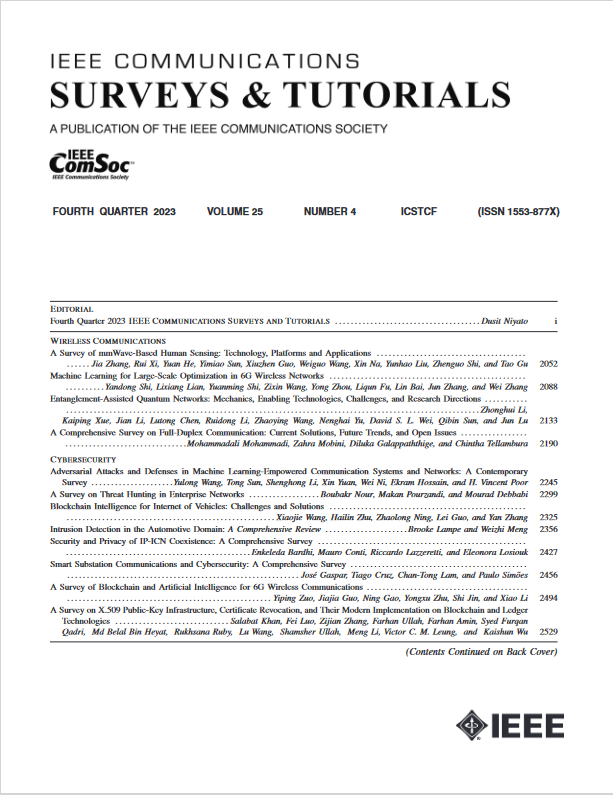无线通信中的干扰负担:从物理层角度全面考察
IF 34.4
1区 计算机科学
Q1 COMPUTER SCIENCE, INFORMATION SYSTEMS
引用次数: 0
摘要
干扰是无线通信社会将完全连接的世界带入生活的最常见障碍之一,在这个世界中,每个人和所有事物都随时连接,旨在支持各种服务和应用程序,这些服务和应用程序在数据速率方面的需求不断增加,具有更高的可靠性和安全性,同时保持可负担的整体系统容量,复杂性和延迟。从本质上讲,干扰清楚地解释了无线通信系统的原始性质,其中总是有不需要的物理信号破坏通信链路,发生在传输信号的物理层(PHY)体系结构中,特别是与无线信道和收发器体系结构的相互作用。因此,在过去的无线技术中,波形设计以及无线信道损伤和手机架构定义了主要的干扰源,导致了符号间干扰(ISI)、载波间干扰(ICI)和同信道干扰(CCI)类型。在这方面,无线技术的最新进展揭示了前所未有的干扰类型,包括数字间干扰(INI)、天线间干扰(IAI)、波形间干扰(IWI)、交联干扰(CLI)和多普勒间干扰(IDI),而预计在不久的将来还会出现其他独特的干扰类型。因此,为了避免和减轻其对5G以外无线接入技术的影响,更广泛地看待干扰已成为一项至关重要的需求。尽管学术界和工业界在文献中进行了广泛的研究,但据作者所知,还没有一项工作提供了干扰源和类型的全面分类框架,以及从物理层的角度对管理技术的回顾。本书旨在填补这一文献空白。在这个调查中,我们提出了一个直观的、通用的、可扩展的框架,对干扰源及其相应的管理解决方案进行分类。特别是,我们将干扰源分为两大类,考虑到用户的兴趣,如自用户干扰(SUI)和其他用户干扰(OUI),我们进一步分类考虑用户对干扰存在的意图,命名为有意SUI (I-SUI),无意SUI (U-SUI),有意OUI (I-OUI)和无意OUI (U-OUI)。据此,我们对干扰源的干扰管理技术进行了分类。最后,该调查提出了5G以外无线系统的开放研究前景和结束语。本文章由计算机程序翻译,如有差异,请以英文原文为准。
Interference Burden in Wireless Communications: A Comprehensive Survey From PHY Layer Perspective
Interference represents one of the most common barriers for the wireless communications society to bring the fully connected world to life, where everybody and everything is connected at any time, aiming to support a wide range of services and applications with increasing demand in terms of data rate with a higher degree of reliability and security, while keeping an affordable overall system capacity, complexity, and latency. Essentially, interference clearly explains the primitive nature of the wireless communications systems, where there is always an unwanted physical signal that disrupts the communication link, occurring from the physical layer (PHY) architecture of transmission signal, its interaction with the wireless channel and transceiver architecture in particular. Therefore, in past wireless technologies, waveform design along with wireless channel impairments and handset architecture define the main sources of interference, leading to inter-symbol interference (ISI), inter-carrier interference (ICI) and co-channel interference (CCI) types. In this line, recent advances in wireless technologies have revealed unprecedented interference types including inter-numerology interference (INI), inter-antenna interference (IAI), inter-waveform interference (IWI), cross-link interference (CLI) and inter-Doppler interference (IDI), while additional unique interference types are expected in near future. Consequently, a broader view of the interference has become a crucial need in order to avoid and relax its impact towards beyond 5G radio access technologies. Despite the extensive research in the literature performed by academia and industry, to the best of the authors’ knowledge, there is no work that provides a comprehensive taxonomy framework of interference sources and types, and a review of management techniques from the perspective of the PHY layer. This work aims to fill this gap in the literature. With this notation, in this survey, we propose an intuitive, generic, and expandable framework that categorizes the interference sources and their corresponding management solutions. In particular, we split the interference sources into two main groups by taking into account the user of interest such as self-user-interference (SUI) and other-user-interference (OUI), which we further classify considering the user’s intention about the presence of interference named intentional SUI (I-SUI), unintentional SUI (U-SUI), intentional OUI (I-OUI), and unintentional OUI (U-OUI). In line with this, we offer a classification of the interference management techniques regarding the source of interference. Lastly, the survey presents open research perspectives for beyond 5G wireless systems and concluding remarks.
求助全文
通过发布文献求助,成功后即可免费获取论文全文。
去求助
来源期刊

IEEE Communications Surveys and Tutorials
COMPUTER SCIENCE, INFORMATION SYSTEMS-TELECOMMUNICATIONS
CiteScore
80.20
自引率
2.50%
发文量
84
审稿时长
6 months
期刊介绍:
IEEE Communications Surveys & Tutorials is an online journal published by the IEEE Communications Society for tutorials and surveys covering all aspects of the communications field. Telecommunications technology is progressing at a rapid pace, and the IEEE Communications Society is committed to providing researchers and other professionals the information and tools to stay abreast. IEEE Communications Surveys and Tutorials focuses on integrating and adding understanding to the existing literature on communications, putting results in context. Whether searching for in-depth information about a familiar area or an introduction into a new area, IEEE Communications Surveys & Tutorials aims to be the premier source of peer-reviewed, comprehensive tutorials and surveys, and pointers to further sources. IEEE Communications Surveys & Tutorials publishes only articles exclusively written for IEEE Communications Surveys & Tutorials and go through a rigorous review process before their publication in the quarterly issues.
A tutorial article in the IEEE Communications Surveys & Tutorials should be designed to help the reader to become familiar with and learn something specific about a chosen topic. In contrast, the term survey, as applied here, is defined to mean a survey of the literature. A survey article in IEEE Communications Surveys & Tutorials should provide a comprehensive review of developments in a selected area, covering its development from its inception to its current state and beyond, and illustrating its development through liberal citations from the literature. Both tutorials and surveys should be tutorial in nature and should be written in a style comprehensible to readers outside the specialty of the article.
 求助内容:
求助内容: 应助结果提醒方式:
应助结果提醒方式:


